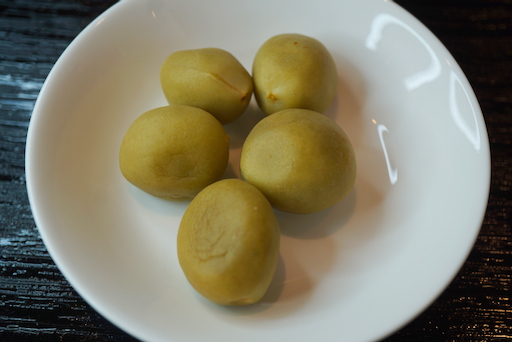We planted a ume fruit 梅 bearing plum tree (prunus mume) about 30 years ago. While ornamental plum trees are quite common, we had to spend some time and effort to find one that bore the plum known in Japanese as ume. (We subsequently found out it is actually an apricot tree and the Japanese green ume is basically an unripe apricot from which plum wine or "
umeshu"梅 is made. Standard "Umeboshi" pickled plum 梅干し is made from yellow ripe "ume".) It arrived in the spring in an envelop as a mere twig mailed from a nursery in Oregon. It spent the summer in a flower pot on the deck but in the fall we didn't know what to do with it so in the absence of any other plan we toed it into our vegetable garden never expecting it to survive the winter. To our surprise it not only survived but thrived producing bumper crops and providing us with the basic ingredient to make some mighty fine plum wine. The last
bumper crop was in 2008. Around that time, a fungal disease (black knot galls) started spreading among plum trees in our neighborhood. Many of the beautiful ornamental plum trees lining the street leading to our house became diseased and many subsequently succumbed. Unfortunately, our plum tree did not escape this fungal disease. The branches became deformed, coated in black cankers. It stopped producing fruit. Many of the branches died. In 2012 we had a Japanese master landscaper redo our backyard. As a result, the tree was moved to a different location and the diseased branches were severely pruned back. It struggled for several years and I had to further prune out the affected branches several times. Frankly, there was not much of it left. We thought this tree was basically lost and even discussed whether we should have it removed. Surprisingly, although it still shows residual signs of the disease, it seems to have overcome the worst of it. It miraculously survived and even started putting out new growth. This year, for the first time since getting sick and since being transplanted, it bore a large number of fruit. One of the branches had so much fruit on it that it broke during a thunderstorm and fell to the ground. The branch is pictured below.
Although the fruit was still rather small and unripe, we decided to harvest it since the branch was already off the tree. In total, the fruit was over 1kg (Below picture on the left). I knew immediately how I could use the fruit because we happened to watch (for the second time) one of the episodes of "
Midnight diner" 深夜食堂 on Netflix. This episode was about "Karikari-koume" カリカリ小梅 which is crunchy small salted plums.
Ingredients:1kg small green plums (left in the picture below).
100g salt (10% of the plum)
2tbs white liquor (I used vodka instead).
Directions
Cull plums with any blemishes, wash, and soak it in cold water for a few hours (right in the picture below).

Remove the remnant of flower (#1) using a bamboo skewers and dry the plum.
Put the plums in a Ziploc bag, add the salt and vodka.
Remove as much of the air as you can and close the bag. Distribute the salt so that all the plums are coated and make a single layer of the plums (#2 in he picture below)
I sandwiched the plums in the Ziploc bag between two sheet pans then placed weight (about 1kg, water filled jars) (#3, in the picture below)
Leave it for 3 days. The color of the plum will change from green to light brown and water will come out (#4 in the picture below).
I moved it to the refrigerator and after several days, placed the liquid and plums in the glass jar with air-tight lid (I used a small amount of Vodka to "sterilized" the jar before adding the plums) (left in the picture below). The liquid (called "Umesu" 梅酢) came 2/3 of the jar (right in the picture below).
The recipe I am following said keep it in the refrigerator 3-4 weeks before eating. I had a taste when I moved the plum to the jar. It was salty and "karikari" meaning crunchy in texture but had a slight bitter aftertaste. Hope this will disappear in a few weeks. We will let you how it goes.






1 comment:
Wow. That is a great story. It's nice to see something in that area that is not diseased and is thriving after 30 years. I've only been with you for 28 years. The twig wins.
Post a Comment